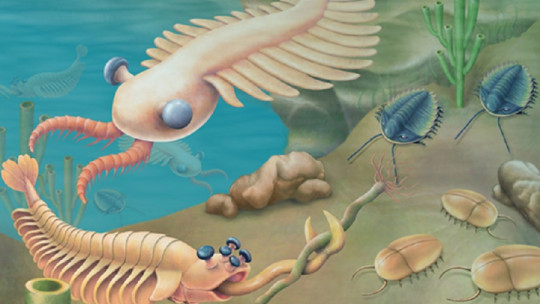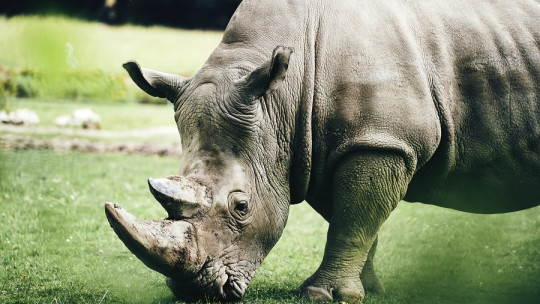The evolution of living beings, that is, the set of changes in phenotypic and genetic characteristics of populations through generations, is something that is taken for granted today. The fossil record and genetic analyzes leave us no doubt about this: every current being has a series of ancestors and living beings are grouped into taxa according to degrees of kinship.
In 1859, this concept was in its infancy, and Darwin postulated in the book “The Origin of Species” the mechanism of natural selection that explained biological evolution, but not without certain reservations.
This is where the not so well-known “Darwin’s dilemma” comes into play, which was a real puzzle for the thinker in his evolutionary postulations. Today we talk to you about unprecedented biological radiation, in a bygone and hostile era: welcome to the cambrian explosion
What is the Cambrian explosion?
The Cambrian explosion or cambrian explosion Translated into English it is a term that refers to the sudden appearance and rapid diversification of macroscopic organisms about 540 million years ago According to research sources, this radiation was especially significant with regard to the “larger” taxa (i.e., the phyla).
This is because during this time the majority of animal groups emerged: arthropods, mollusks, echinoderms and chordates and 75% of the representative subdivisions on earth. Explained more simply, one could say that the great “pinnacles” of life were established during the Cambrian, in addition to the small branches split from them , as cephalopods or bivalves could be today within the large group of mollusks. In addition to this incredible diversification, other events occurred:
Throughout this evolutionary radiation, which lasted about 20 million years, at least 11 of the 20 phyla of metazoans (animals) recorded today appeared Of course, this is not the only “explosion of life” recorded throughout the history of the Earth since, for example, the Triassic-Jurassic mass extinction allowed the subsequent dominance of the dinosaurs. The replacement of species once many ecological niches are suddenly vacated is nothing new, although none of them have been comparable to the Cambrian explosion.
Among the most famous living beings belonging to this geological division we find the trilobites, extinct arthropods that included some 4,000 species and of which, luckily, a large number of fossils have reached us. Other common representatives were certain brachiopods, similar to clams and cockles, or the well-known anomalocaris, a genus of shrimp-shaped predators that caught their prey with their hook-shaped endings. At this time, these primitive beings were the top of the food chain in the planet’s oceans.
However, according to professional portals such as National Geographic magazine, there is a probability that this event was “exaggerated” a bit, since It is possible that the fossil record that has come down to us from this stage is much greater due to the mineralization of the skeletons of various species with respect to the poor fossilization capacity of their soft-bodied predecessors.
Causes of the Cambrian evolutionary radiation
At this point, it is necessary for us to point out that we are faced with hypotheses, all of them equally valid (with more or less scientific support), but which cannot be proven in their entirety. Various research articles postulate the possible reasons for the Cambrian explosion and we show them briefly in the following lines.
1. Environmental triggers
Oxygenation of water and changes in its chemical composition have been postulated as the most likely environmental triggers that gave rise to the Cambrian explosion.
Of course, The process of metabolizing food in the presence of oxygen (cellular respiration) provides much more energy than anaerobic metabolic pathways, which is why an explosion of life makes biological sense when the values of this gas reached almost the current levels of the oceans on Earth. Even so, recent studies that analyze certain chemical compounds in rocks from these geological stages report that the increase in global oxygen probably did not occur as drastically as most people believe.
Increases in environmental nutrients such as phosphorus or nitrogen could also partly explain this exaggerated radiation although this fact has not been able to be directly correlated with a greater diversification of species or the appearance of so many phyla, as happened in the Cambrian.
2. Developmental genes and molecular clock
The Cambrian explosion could not only find its reason in environmental determinants such as the collision of continents, the greater presence of oxygen, a greater availability of nutrients and many other factors extrinsic to the individual, but part of the truth could also be found in the people themselves. genes of organisms.
A clear example of this are the Hox genes, which, during embryonic development, specify the body plan of living beings by activating or inactivating other genes in certain parts of the body (explained in a very rudimentary way). The evolution of Hox genes, for example, could explain the appearance of more complex bodies throughout this period
Molecular clocks have shown that the radiation of the three bilateral animal clades during the early Cambrian period occurred after the diversification of the Hox genes, so unfortunately, this theory has lost quite a bit of steam recently. If Hox genes diversified before clades, this would not be an adequate explanation for the Cambrian radiation.
Darwin’s dilemma
Perhaps we can understand the puzzle that this rapid appearance of new species and phyla represented for Darwin in his time, since even today a completely irrefutable answer cannot be given regarding the issue.
Darwin’s speech always defended the gradual succession of modifications in living beings, a fact that ruled out the appearance of an “evolutionary Big Bang”, exactly what the Cambrian explosion is. According to various studies, The acceleration of physical modifications during the Cambrian exceeded current evolutionary mechanisms by 4 times while genetic variations increased 5.5 times.
As indicated by professionals in the field who have studied this phenomenon during the last 20 years, “a moderately accelerated and sustained evolution for a few tens of millions of years could give rise to an evolutionary explosion”, a fact that, to a certain extent, agrees with Darwin’s initial postulates.
Also is true that colonization of new environments can promote a skewed and much faster evolutionary rate , since a taxon that acquires an innovative characteristic could require an evolutionary explosion to occupy new niches. For example, if a primary adaptation were the acquisition of legs and a way to land, it is to some extent logical to think that evolutionary mechanisms would accelerate for a time in the group with legs, since it would find itself with thousands of empty niches to exploit after a unique evolutionary history in water.
Summary
If we wanted to show one thing with all this conglomeration of terminology, ramblings and hypotheses, it is that, unfortunately, there are questions that surely can never be answered in their entirety. This makes phylogenetics and paleontology sciences that are as exciting as they are frustrating, since debate and rumination reign in a world where we try to guess what happened 530 million years ago. The Cambrian explosion, as impressive as it is, remains without a definitive answer.









